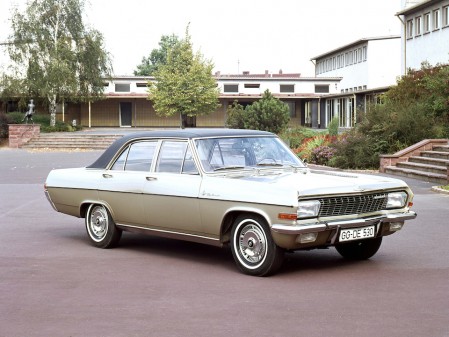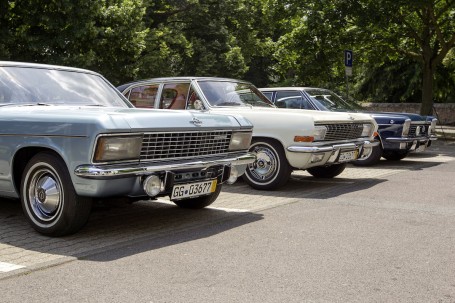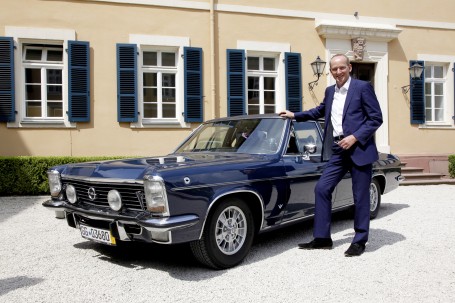- Leichtigkeit des Seins: Ab Ende 1965 verstärkte die zweitürige Coupé-Variante des Diplomat die Troika – ein Traumwagen.
- Großes Graubrot: Als preiswerter, aber eher mager ausgestatteter Einstieg in die KAD-Klasse hatte der Kapitän 1970 ausgedient.
The year is 1964. In Bonn, the capital of the recently formed Federal Republic of Germany, Chancellor Ludwig Erhard is currently laying the groundwork for the country’s economic miracle. In Oslo, Martin Luther King is being awarded the Nobel Peace Prize, and in Rüsselsheim, the legendary luxury trio is rolling off the production line for the first time ever: the Kapitän, Admiral, and Diplomat. With names like this, it was obvious that these cars were there to make a statement. And the KAD series did just that, sending ripples throughout the automotive world.

Graceful design: In 1964, the Diplomat, with its long body and vinyl roof, was the flagship model of the KAD series.
Stately in size, measuring almost five meters long, and with a wheel base of more than 2.8 meters, the Kapitän, Admiral, and Diplomat were among the most awe-inspiring sedans of their day. It isn’t just the sheer size and elegant, sleek design that continue to turn heads to this day. Opel didn’t hold back when it came to the drive system either: Even the base models of the Kapitän and Admiral were fitted with large straight-six engines, just like their immediate predecessor, the Opel Kapitän 2.6.

The big three: Opel joined the high-end and luxury market with the arrival of the Diplomat A V8, Admiral A, and Kapitän A (from front to back).
And then came the new leader of the pack: the Diplomat. Opel’s top model picked up speed quickly, equipped with a 4.6-liter eight-cylinder engine under its meter-long hood. One year later, the release of the Diplomat Coupé, followed shortly thereafter by the sedan version, meant that the hierarchy on the German Autobahn was permanently turned on its head. The 5.4-liter eight-cylinder engine churned out 230 hp, meaning the Diplomat could reach speeds of 200 km/h. This was unheard of in the 1960s, as demonstrated by Opel’s smallest member of its fleet at the time: the 40-hp Kadett A that could only reach its top speed of 120 km/h after much coaxing and cajoling.
Opel’s top model provided a level of luxury that was truly decadent in its time. It came with electric windows, air-conditioning, power steering, and, at the very height of comfort, an automatic gearbox. In those days, the driver rarely felt the gear shifts for the simple reason that this hardly ever happened. The two-speed automatic transmission was able to skillfully surf the V8 engine’s torque curve so that the first gear was only really necessary to get the car going off the line.

Three faces, two generations (left to right): Kapitän B (1969), Admiral A V8 (1965), and Diplomat B V8 (1969) at a family gathering.
The luxury sedan clearly left a lasting impression, as is evident from a test report written back in 1965. In the words of Reinhard Seiffert, writing for the ‘auto, motor und sport’ magazine: “We were effortlessly cruising along the Autobahn at over 150 km/h without even realizing it. In the Diplomat, you drive faster than in most loud and tightly sprung sports cars, but it doesn’t feel like you are pushing the limits in term of driving performance.”

Royal blue: 5.4-liter engine and 230 hp – Opel boss Karl-Thomas Neumann gets to grips with the Diplomat V8.
The KAD B-series, which went into production in 1969, made it a little easier for outsiders to differentiate between the top-of-the-line Diplomat and its two fellow models, both with maritime-themed names. Its headlights and taillights were positioned vertically, whereas they were horizontally aligned on the Admiral and the Kapitän. Even with its automatic transmission, newly upgraded to three speeds, and more aerodynamic design, the fuel economy of the large sedan could certainly have been better, and it was for exactly this reason that the Diplomat went out of production eight years later. Following the oil crisis, it was time for compact cars to shine, with the large V8 dinosaurs being put out to pasture.
Prices from Yesteryear
The cost of the KAD series made it particularly attractive in comparison to other luxury cars, yet it was still out of most people’s price range. The Diplomat A cost 17,500 marks, while the exclusive coupé, produced by Karmann, would set you back 25,000 marks. In contrast, back then a Kadett A was available for around 5,000 marks. The price of gas back then was roughly EUR 0.29 per liter, with the average monthly wage at around EUR 250, both adjusted for inflation.
A Sound Investment
Happy is he who could afford a Kapitän, Admiral, or Diplomat all those years ago, and has managed to look after it. They have increased in value significantly, with models in good condition fetching prices upwards of EUR 20,000. The extremely rare Diplomat A Coupé now goes for more than three times the original asking price when new – if you can find one, that is.
Ready for Government Service
The stretched version of the Opel Diplomat B was true to its name: With a 15 cm longer wheelbase and more space inside, the luxury liner’s front fenders were fitted with flag holders, making it the perfect choice to serve as a chauffeur-driven limousine for Bonn’s government officials.

